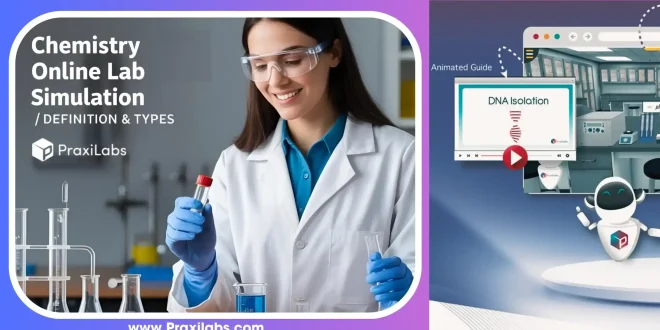Last Updated on September 17, 2025 by Muhamed Elmesery
Conducting experiments in a chemistry online lab simulation helps students link chemical computations with real-world laboratory experiences by providing a safe and interactive learning experience.
In this blog post, we will explore what a chemistry online lab simulation is, its types, and how it introduces several benefits and features to increase students’ learning outcomes, and more!
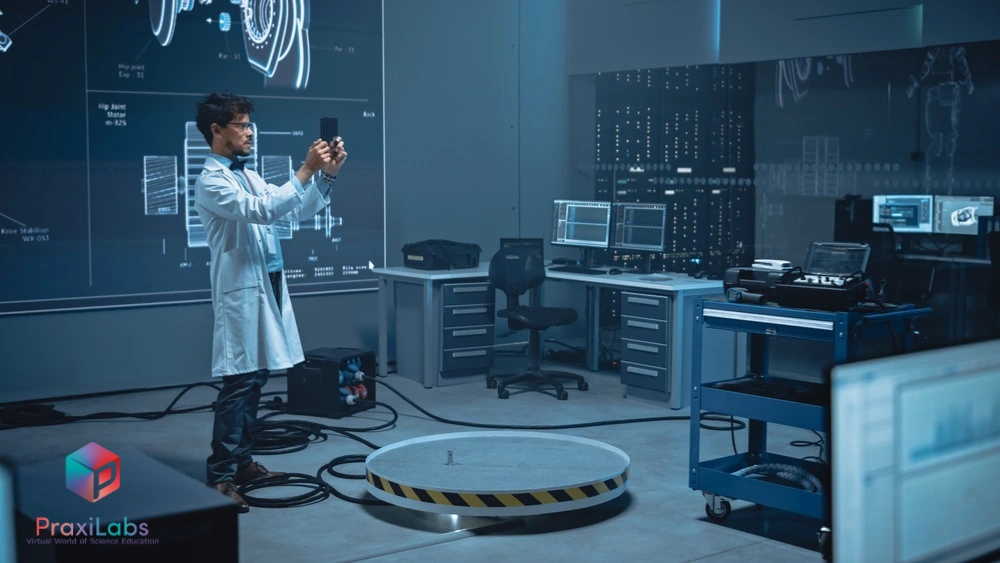
Table of Contents
What is chemistry online lab simulation?
Chemistry online lab simulation is a computer-based virtual lab that simulates real chemistry labs in various disciplines, such as analytical chemistry, organic chemistry, inorganic chemistry, and more.
Just imagine that your students can conduct their chemistry experiments in a safe environment without any risks such as dealing with toxic or radioactive substances, they can also perform experiments anytime and anywhere.
Advantages of chemistry online lab simulation for colleges
The primary advantage of chemistry online lab simulation for Colleges is that it provides students with access to realistic chemistry labs and enriches their knowledge and understanding through a variety of informational and educational content to enhance their learning outcomes. the goal is to provide equal opportunities for an enhanced STEM education for students everywhere.
A chemistry online lab simulation for Colleges can be more cost-effective compared to real labs. Setting up and maintaining a physical chemistry laboratory requires significant resources, including equipment, tools, chemicals, materials, and safety measures. Interactive chemistry online lab Simulations reduce these costs by eliminating the need for physical materials.
Get your virtual lab simulation free online access for immersive virtual labs now!
Types of Chemistry Online Simulations
At PraxiLabs, we offer three types of chemistry online simulations for students:
Analytical Chemistry Labs
In analytical chemistry testing labs, students learn about the quantitative and qualitative analysis of chemical substances used in various industries. For example, the determination of the concentration of citric acid in soda is performed using a titration method.
Try our simulation “Determination of Concentration of Citric Acid in Apple Juice” and teach your students how to differentiate between acids and bases, understand the meaning of acid-base titration, standard solutions, and neutralization reactions. Additionally, students will learn how to measure the amount of citric acid in beverages available on the market.
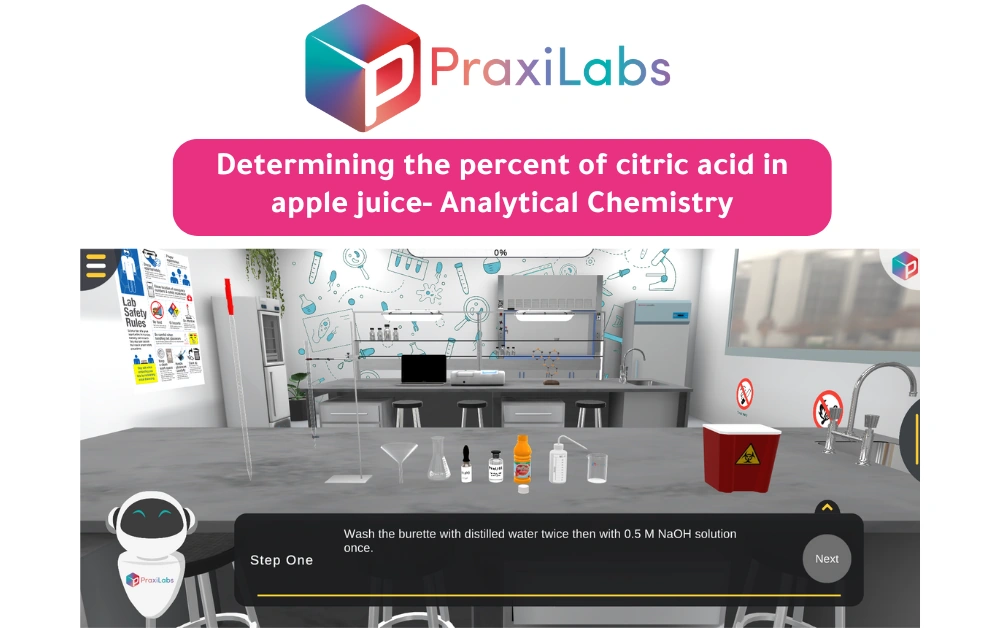
Organic Chemistry Lab Online
The organic chemistry lab online focuses mainly on studying carbon-based molecules. Students study and learn the characteristics, reactions, reactivity, and synthesis of organic compounds.
For example, in the Saponification reaction and soap formation, students gain a deeper understanding of how to run organic chemical reactions, learn more about organic hydrolysis procedures, and comprehend the saponification reaction mechanism and function.
Inorganic chemistry online labs
At the inorganic chemistry online labs, students study the characteristics, reactivity, and the synthesis of inorganic chemistry.
Inorganic chemistry contains several vital topics such as chemical formula, acid base chemistry, chemical bonds, magnetic and electronic properties, molecular orbitals, redox reaction, and more!
For example, the Test for Sulphite Radical , students learn how to define and differentiate between sulfite ions and other acid radicals through their chemical formulas, properties and reactions. They understand how to determine the presence of sulphite radical, identify sulfite radicals containing salts experimentally, and classify them according to their acid radicals.
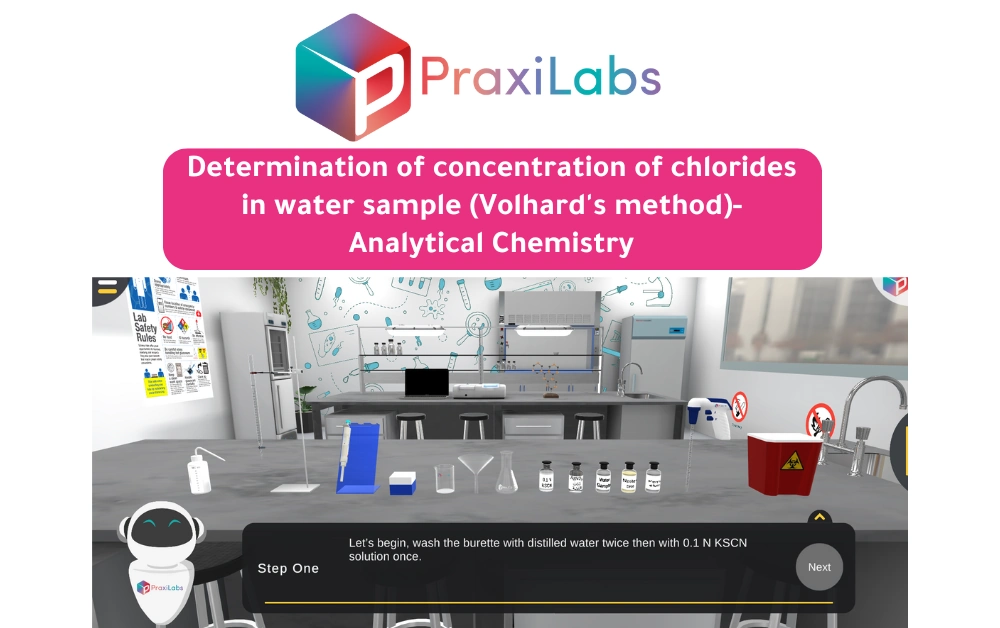
Examples of chemistry online lab simulation
At PraxiLabs, we provide several interactive virtual simulations in chemistry. Let’s explore some of them!
Chemical Analysis Lab:
- Determination of Sulphuric Acid Concentration by Titration.
- Analysis Mixture of Sodium Hydroxide and Sodium Carbonate by Warder Titration.
- Determination of Concentration of Acetic Acid in Commercial Vinegar.
- Determination of Citric Acid in Soda by Titration Simulation.
- Determination of Silver Nitrate by Fajan Method Simulation.
- Determination of Concentration of Silver Nitrate by Mohrʼs Method.
- Determination of Water Hardness by Complexometric Titration.
- Standardization of Potassium Permanganate Virtual Lab Simulation.
- Standardization of Sodium Thiosulphate using iodometric titration.
- Determination of concentration of chlorides in water sample by Volhard’s method.
- GC MS Analysis Virtual Lab Simulation.
- NMR Analysis Virtual Lab Simulation.
- IR Analysis Virtual Lab Simulation.
- (Strong Acid and Strong Base Titration) HCl/NaOH Virtual Lab.
- Weak Base/Strong Acid Titration Virtual Lab Simulation.
- Test for Unknown Acidic Radical.
- Aspirin Titration.
- Determination of Citric Acid Concentration in Apple Juice through Acid/Base Titration.
- Test for Unknown Basic Radical.
- Preparation of Ethyl Propionate (Fisher Esterification).
- Grignard Preparation.
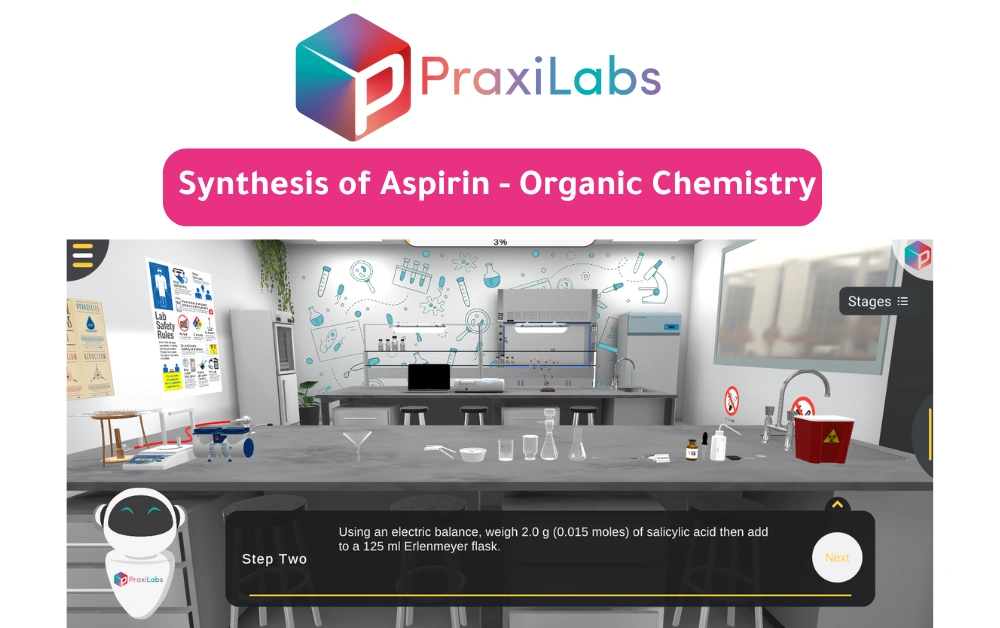
Organic Chemistry:
- Tests for Carboxylic Group.
- Tests for Phenolic Group.
- Diels Alder Reaction.
- Test for Amide Group.
- Friedel Crafts Acylation of Anisole.
- Tests for Hydroxyl Group.
- Tests for Aldehydic and Ketonic Groups.
- Synthesis of Aspirin.
- Esterification.
- Electrophilic Substitution (Azo Coupling) Reaction of Alkyl Halides (Hydrolysis of Alcohols).
- Saponification Reaction.
- Preparation of Paracetamol.
- Preparation of B-Naphthyl Acetate.
- Claisen Schimdt Reaction (Mixed Aldol Condensation).
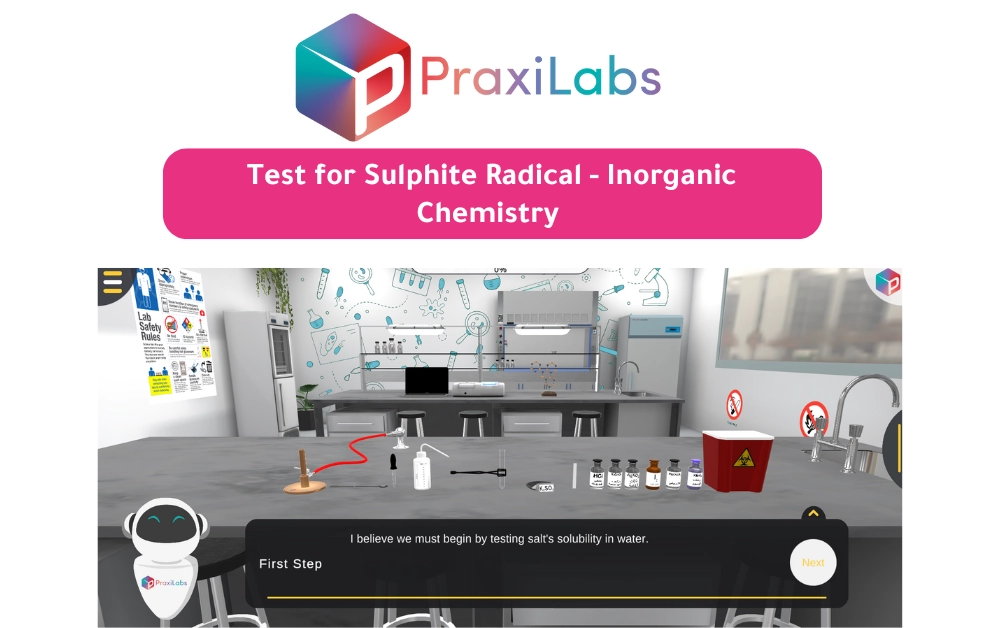
Inorganic Chemistry:
- Test for Manganous Radical.
- Barium Confirmatory Test.
- Test for Calcium Radical.
- Test for Magnesium Radical.
- Test for Ammonium Radical.
- Test for Sodium Radical.
- Test for Potassium Radical.
- Flame Test.
- Test for Sulphite Radical.
- Test for Carbonate Radical.
- Test for Bicarbonate Radical.
- Test for Sulphide Radical.
- Test for Thiosulphate Radical.
- Test for Chloride Radical.
- Test for Bromide Radical.
- Test For Magnesium Radical.
- Test for lodide Radical.
- Test for Sulphate Radical.
- Test for Phosphate Radical.
- Test for Mercurous Radical.
- Test for Silver Radical.
- Test for Lead Radical.
- Test for Cadmium Radical.
- Test for Mercuric Radical.
- Test for Cupric Radical.
- Test for Chromic Radical.
- Test for Ferric Radical.
- Test for Aluminum Radical.
- Test for Zinc Radical.
- Test for Nickelous Radical.
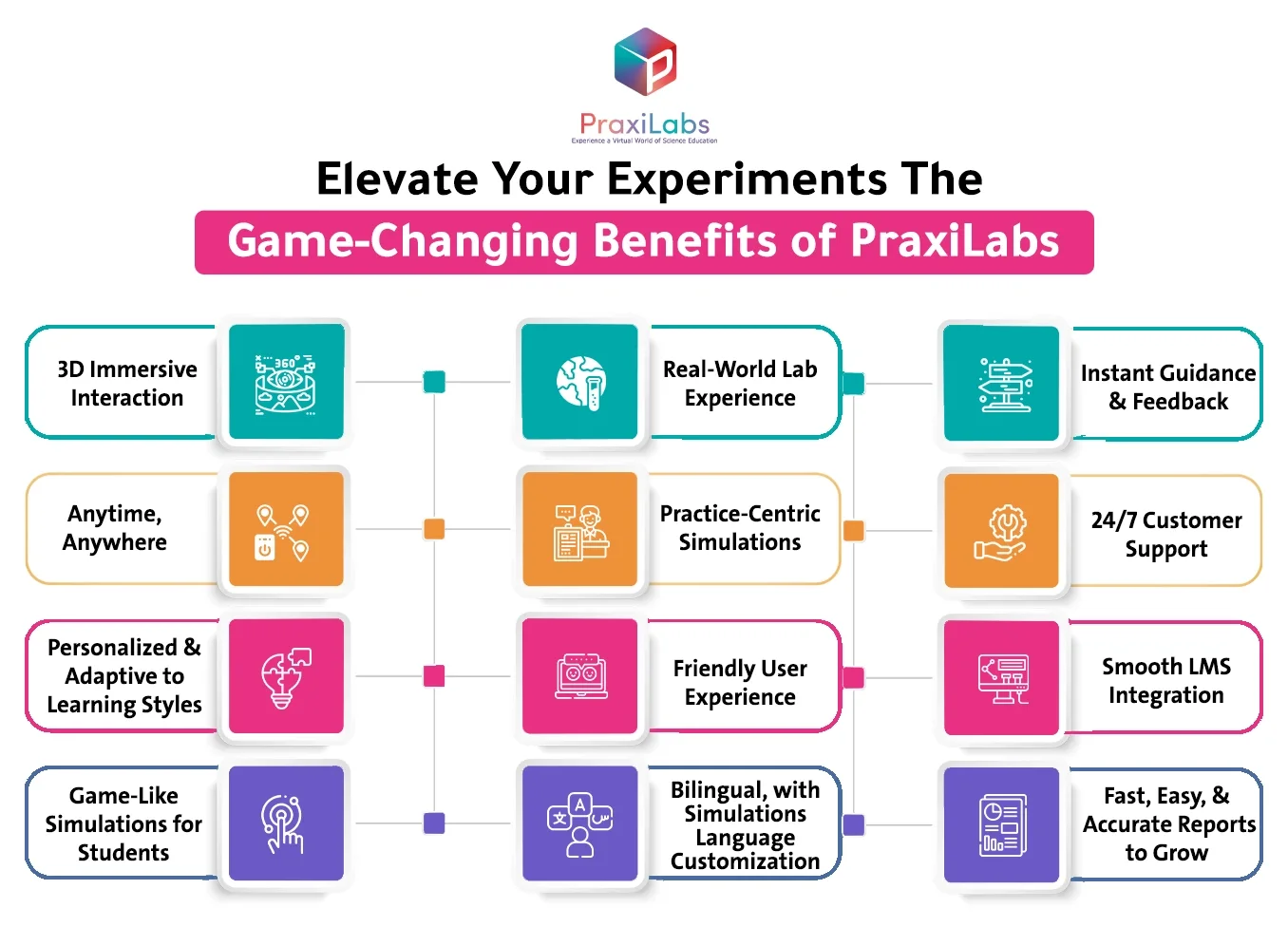
Why Praxilabs considers the best Virtual Labs Simulator
With PraxiLabs, students can actively learn while performing their 3d science experiments. Your students get a full experience, with guidance and learning materials to further aid the learning process rather than just following instructions and completing tasks.
PraxiLabs provides a complete solution, not just a basic “tool” educational institutions. Instead, it offers an interactive and enriching learning experience by providing students with materials, guidance, experience and engaging approaches, which further enhance the learning process, make it more interactive, and eliminates concerns such as costs, safety hazards, and other timitations typically found in traditional labs.
Increase your Students’ Learning Retention and Engagement With PraxiLabs’ virtual lab simulations!
FAQs
What is the website to simulate chemical reactions?
PraxiLabs offers an online platform and mobile app that simulate chemical reactions in sub-disciplines such as analytical chemistry, organic, and inorganic chemistry.
How can you use a virtual lab for teaching chemistry?
By using chemistry online lab simulations, you can monitor how well your students are doing, track their performance in each chemistry experiment , and get insights into how they’re doing. Additionally, virtual lab chemistry simulation features can help you identify students who may be struggling with certain steps or who need extra help in order to complete the experiment.
Are virtual labs effective?
Several studies have shown that virtual labs can be as effective as physical laboratories in teaching certain subjects such as chemistry. Furthermore, integrating virtual lab simulations into teaching strategies has been shown to yield high student engagement, improved learning outcomes, and positive feedback.
PraxiLabs Virtual Labs include a range of online science experiments in physics, chemistry and biology
 PraxiLabs A virtual world of science
PraxiLabs A virtual world of science

